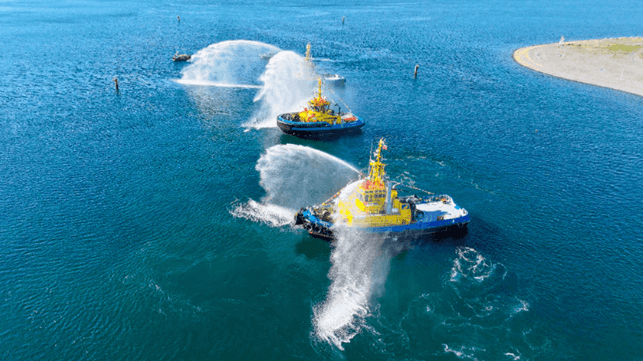Corvus Energy Battery System Powers Latin America’s First Electric Tugboat

[By: Corvus Energy]
The first electric tugboat in Latin America, the result of a collaboration between the largest towage services operator in the Americas, SAAM, and Chilean national oil company, Enap, is powered by a lithium-ion marine battery system from Corvus Energy.
Based on an exclusive design from naval architects Robert Allan Ltd (RAL) and built by SANMAR Shipyards for SAAM, the battery-electric tug supports ship berthing and deberthing maneuvers in one of the southernmost terminals in the world—Puerto Chacabuco in the Aysén Region of Chile in South America.
About the electric tugboat
The battery-powered vessel, named “Trapananda” in honor of the Chilean Patagonia region where the tug operates, measures 25 meters in length, 13 meters in beam and boasts 70 tons of bollard pull capacity, enabling it to assist large vessels under challenging harbor conditions.
Third electric tug in the SAAM fleet
SAAM, including its division SAAM Towage, operates more than 200 tugboats around the Americas. Notably, the Trapananda is the third battery-electric tug to join the SAAM fleet. In May 2024, SAAM launched two electric tugboats in the Port of Vancouver in Canada, making SAAM among the first zero-emission tug operators in North America. All three tugs are RAL-designed, SANMAR Shipyards-built and equipped with a Corvus Energy battery system.
Environmental and operational benefits
According to SAAM, battery-powered tugboats are an important part of the Company’s 2030 Sustainability Strategy, which includes a goal to neutralize 65% of greenhouse gas emissions from the operation of their fleet through reduction and offsetting initiatives. (Source).
Fully battery-powered operations produce zero emissions and are almost completely silent. This results in significant environmental benefits, including reduced carbon footprint and less noise pollution, both in port and underwater, protecting coastal communities and marine life alike. Compared to diesel-powered tugs, electric tugboats also offer operational advantages including reduced fuel and maintenance costs.
After its first year operating electric tugs in Canada, SAAM reported its “carbon intensity index [had] fallen 72% compared to diesel-powered units with similar features, and a further 90% reduction is projected for the second year of operation. In addition, the electric tugs’ operating costs were reported to be 70% lower than its diesel-powered peers.” (Source).
Corvus Energy involvement
The Trapananda is equipped with a Corvus Orca ESS, the most installed marine energy storage system, used onboard over 700 maritime vessels worldwide. Like the SAAM electric-powered tugs operating in Vancouver, the Trapananda is outfitted with a 3,616-kWh capacity battery system.
“We are proud to support SAAM, RAL and SANMAR by supplying the battery system for the first electric tugboat to operate in Latin America, as well as for the Vancouver-based tugs,” said Tor-Gunnar Hovig, Head of Region Americas at Corvus Energy. He adds, “SAAM is leading the way towards more sustainable port operations in the Americas and beyond with these RAL-designed, SANMAR-built tugs.”
"The arrival of the Trapananda is a turning point for our industry. It signals our decisive move toward cleaner, more efficient, and environmentally friendly operations. This project represents our vision for the future: we're developing solutions that not only assist and tow ships but also help mobilize a shift toward a truly sustainable logistics chain. We consider Corvus a strategic partner in this journey,” said Pablo Cáceres, Sustainability and Development Director of SAAM Towage.
The products and services herein described in this press release are not endorsed by The Maritime Executive.
